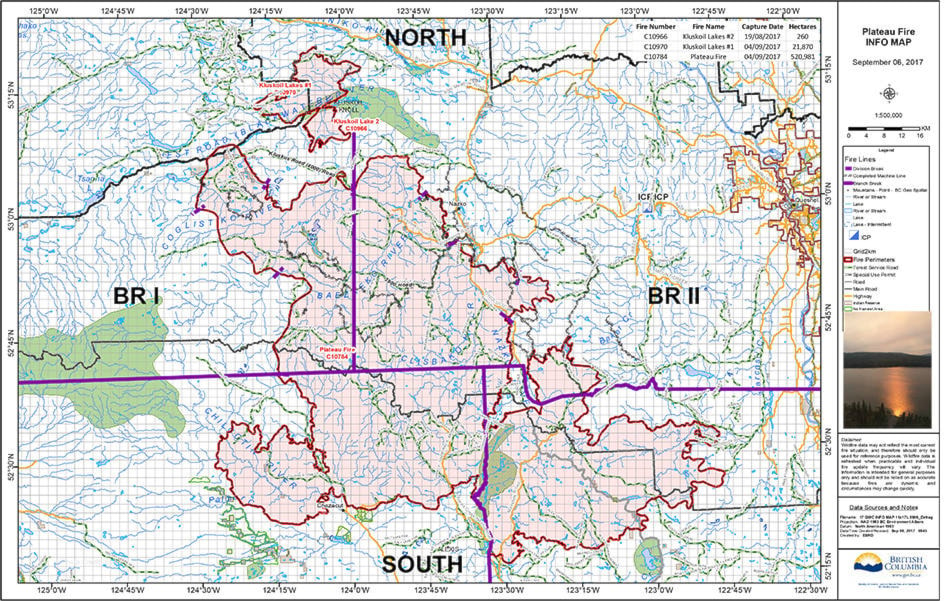Fire information officers visited Quesnel Tuesday with the following updates:
Plateau North location: 60 km west of Quesnel and 60 km northwest of Williams Lake
Status: This fire is 520,979 hectares. Resources on the North Plateau: 210 firefighters and 66 pieces heavy equipment, 13 helicopters.
Cause: Lightning.
Objectives: Near Kluskus fire crews will continue creating a machine guard south of Bishop Creek. The fuel free line is being soaked and a dozer line is being put in from 4000 road to Bishop Creek. The 50 foot black line south of 4000 road is being mopped up.
North of Nazko, crews are mopping up and patrolling the fire’s edge along Redwater Creek, as well as along the MacKay Creek drainage. Hose line is being put in from 4400 Road to Marmot Lake Road and guard is being established around structures from 5600 Road to 5606 Road.
An excursion which occurred at the 3900 Road is being Extinguished at 3905 Road. Southeast of Nazko, guard is being installed south of the 6000 road staging.
Evacuations: Evacuation Order implemented, and an Evacuation Order was downgraded to an Alert near Batnuni to northeast of the Nazko area. Head to: http://cariboord.bc.ca for more information.
Kluskoil Lake #1 location: west side of Kluskoil Park, approximately 110 km northwest of Quesnel
(This fire has merged with C11058 – Swede Creek Fire.)
Status: Estimated at 21,870 hectares – out of control. The change in the size to the fire is due to updated perimeter mapping over the last few days.
Cause: Lightning
Resources: 40 firefighters, six pieces of heavy equipment.
Objectives: Guard is being constructed in the northeast corner of the fire. A 50 ft blackout is being put in on secured lines around the guard in the northeast and southeast corners.
Firefighters return to school
• A large segment of our workforce is students who are employed with us on a seasonal basis. As such, many return to school in the fall.
• This is a situation we normally face at this time of the year. We prioritize the use of our resources and offer extensions until mid-to-late September to those who are able to stay. We also redeploy personnel and resources as necessary to ensure we maintain adequate response capacity.
• Where and when necessary, we can use contract and emergency firefighters or bring qualified and experienced Type I firefighters in from other jurisdictions.
Hiring local
• There is a strong culture of safety within our organization; it’s always our top priority. We must ensure that anyone fighting fires has adequate training. Our firefighters must also meet physical fitness standards, national and provincial, through regular fitness testing.
• Contract firefighters also have significant training and are experienced crew supervisors. They have extensive knowledge of fire line operations and safety.
• We make every effort to hire locals as emergency firefighters for mop-up, patrols, camp demobilization and other support functions.
• Typically, emergency firefighters who have valid S-100 certification are hired on an “as and when required” basis when all local and out-of-province resources are fully engaged.
• Crews and personnel we bring in from out of province are Type 1 experienced firefighters and specialists who are able to assist in providing emergency fire response. They also allow an opportunity to provide rest days for our crews in the event of an active prolonged fire season. Proper rest is essential for fatigue management as it is needed to ensure personnel’s safety.
• If you have a valid S-100 certificate and are in good physical health, you may leave your name and contact information with your local fire centre in case there are opportunities to help out.
• Operations affect the local economy in many ways, through gas stations, convenience stores, hotels, groceries, trucks, equipment, loggers, equipment operators, etc.
